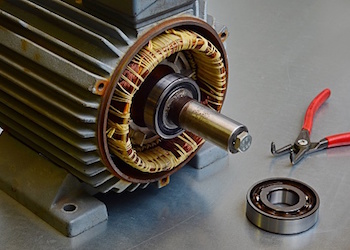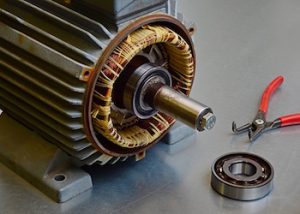
Intelligent motors and actuators
“Many actuators are what might be termed 'dumb,' meaning they only do one thing and have no means by which they can be managed and operated in more subtle ways." —Tom Venetis
February 17, 2017 | By Tom Venetis
 Old electric motor needs maintenance
Old electric motor needs maintenance 
In the food and beverage industry, motors need to meet certain safety and contamination prevention requirements.
Mechanical power transmission technologies are getting smaller and coming with new safety features and intelligence, making them indispensable in such market segments as the food and beverage industry.
Jeff Moore, vice-president of marketing, mechanical, with Baldor Electric Co., says makers of motors and other mechanical power transmission technologies are finding a growing market for their wares in the food and beverage industry, but only if the technologies meet certain conditions.
“Safety is a primary focus in specific industries, such as the food and beverage industry,” Moore says. “We have all seen companies have recalls, such a Blue Bell Ice Cream, which recently had the issue of listeria. So, what we are seeing are companies looking at technologies that use stainless steel and moving to the use of synthetic lubricants.”
Mechanical power transmission
The food and beverage industry needs a wide array of motors and mechanical power transmission technologies, products that can perform with a high degree of reliability but can also work safely in processing environments where risks of contamination to food or beverages need to be eliminated.
Motors, as one example, need to meet certain safety and contamination prevention requirements. These include being able to withstand the daily wash-downs that happen in food processing and beverage making operations. These wash-downs happen frequently with high-pressure hoses and the use of special cleaning agents to destroy potentially harmful bacteria. Motors and other systems need to have an IP65 and above rating for wash-down protection. The Ingress Protection (IP) rating system is a classification system showing the degrees of protection from solid objects and liquids. Motors should also have high efficiency gearing and couplings and sheaves, and bushings that and operate in both wet and dry applications. A stainless-steel design is now expected to further to reduce the chances of bacterial contamination.
“When it comes to food producers and mechanical power transmission products, they have specific questions and needs,” Moore explains. “They will ask, ‘How do I know that these products coming into my plant are designed to withstand Clean-In-Place processes? Are the products water-tights and can they be used during high-pressure wash-down procedures involving high pressures and high temperatures, and done at close range? We also see that covers are important in the food industry and we introduced a metal-detectable end-cover specific to the food industry.”
These end-covers that Baldor makes available are constructed from a high-density polyethylene (HDPE) material that is embedded with stainless steel particles. This allows the end covers to be detected by X-ray equipment and metal detectors used in the food and beverage industry to detect metal materials that may have fallen into the foods or beverages being prepared. The metal in the end covers will ensure that if one falls into the food preparation process it will be found by the detectors and removed.
Linear motion
Niklas Sjostrum, the product line manager for Thomson Industries says that his company’s linear motion systems and precision linear actuators are made to work in food and beverage processing and packaging plants, and are rated at IP65 so at to meet the wash-down requirements need for such environments.
“Not only with water, but with detergents as well,” adds Sjostrum. “Material selection is key as is the ability to clean it down without too many pockets that can let bacteria hide away and which can cause bacterial growth later. That is a major challenge for technologies to work in these kinds of environments.”
Sjostrum gives the example of the company’s PC-Series Precision Linear Actuators: “The outer design is sleek and clean with no slots for other peripheral attachments. The components are made from stainless steel and the rod is completely stainless steel, and there are seals between each compartment, such as the bearing house, so nothing can come out of the unit and nothing can come into the unit. We also added a sophisticated motor mounting system with the sealing seal going all the way back to the motor. We seal off every different compartment so there is no chance for leakage or for anything to penetrate the unit.”
Smart actuators
Another feature companies are looking for with actuators is for the actuators to be “smarter.” Many actuators are what might be termed “dumb,” meaning they only do one thing and have no means by which they can be managed and operated in more subtle ways. Think of such “dumb” systems as a light switch that only has one function, to turn a light “On” or “Off.” Such switches offer no means to control the electrical flow to a light so it may be dimmed, for example. These switches can only turn the light “On” or “Off” and the light stays at one level of brightness as all times. “Smart” actuators can be likened to switches that allow a user to dim that light to the level of brightness desired.
“Our customers are asking for a little bit more intelligence in the actuator, such as position feedback, low-level switching, the ability to use low-power wires to plug into a PLC for greater control, as opposed to a double-pole, double-throw switch and BUS technology as well, mainly on the J1939 CAN BUS and LIN BUS,” says Chard Carlberg, product line manager, industrial linear actuators with Thomson Industries.
“Intelligence allows people to use the actuators in environments where they would not have been able to use them before,” adds Travis Gilmer, product line manager with Thomson Industries. “With intelligence, it allows you to have [the actuator] move to an exact point and to tell you when it has reached that point, for example. With basic actuators, you don’t have that ability. The people who are using these kinds of actuators are using them in machines where it will be communicating with other moving parts in a system that the actuator has to interface with.”
Tom Venetis is a Toronto-based freelance writer. Reach him at venetis@rogers.com.
